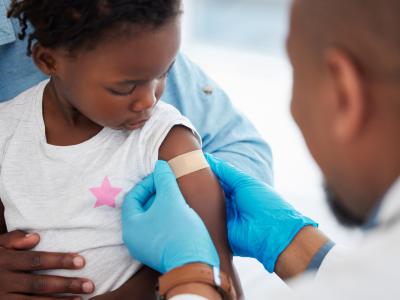Oct 7, 2010 (CIDRAP News) As the nation enters its first flu season under a new universal flu immunization recommendation, federal health officials and representatives from several professional groups today gathered in Washington, DC, to rally support for seasonal flu vaccination, armed with new information about vaccine patterns in physicians, consumers, and mothers.
Tom Frieden, MD, MPH, director of the US Centers for Disease Control and Prevention (CDC) said the new universal flu immunization recommendationthat all people over age 6 months should get the vaccinewill greatly simplify the flu vaccine message. "You and your doctor don't need to wonder anymore, and there is plenty of vaccine available this year, well before flu is circulating," he said at a media briefing hosted by the National Foundation for Infectious Diseases (NFID).
A universal flu vaccination policy is also useful because the disease can be serious and disabling, even in healthy people, Frieden said. He added that when individuals are vaccinated they reduce time missed from school and work and help protect vulnerable people around them.
Though he said it's difficult to make predictions about what strains will circulate throughout the season, early indications from US and international labs suggest that the current circulating strains are a good match with the strains in this year's trivalent seasonal flu vaccine, including the 2009 H1N1 virus.
Dan Jernigan, MD, MPH, deputy director of the CDC's influenza division in the National Center for Immunization and Respiratory Diseases, said the influenza A H3N2 virus has been circulating in different parts of the globe over the summer and into fall. He said US officials expect the virus may circulate in greater numbers in the fall.
He said that, compared with other strains, H3N2 viruses often cause more severe illnesses, so the expectation that the strain will circulate in the United States this season is another reason to get vaccinated.
Vaccine distribution
As of Sep 24 about 119 million doses of seasonal flu vaccine have been distributed, 30 million more than this time last season, Jernigan said.
Stephan Foster, PharmD, a representative from the American Pharmacists Association and liaison to the CDC's flu vaccine advisory group, told reporters today that pharmacies administered 14 million doses of seasonal and H1N1 vaccine last flu season, accounting for 10% of all doses given. He said pharmacies are on track to exceed that this year. Foster is professor and vice chair for community practice at the University of Tennessee College of Pharmacy.
He said community pharmacies are the most accessible vaccine provider and are especially useful for targeting people ages 19 to 49, who often don't have a primary care provider. "But they do walk into pharmacies," he said.
Uptake in physicians
William Schaffner, MD, NFID president, unveiled the results of NFID surveys on flu vaccine behaviors in physicians, consumers, and mothers. The NFID provided background materials on the polls to journalists during the press briefing.
He said public attitudes about flu vaccination can sometimes be as unpredictable as the virus itself; some years uptake is lukewarm, with people rushing to get it in other years. Schaffner is chairman of preventive medicine at Vanderbilt University School of Medicine and a professor of medicine in the school's infectious disease division.
The NFID's survey of 400 primary care physicians revealed that 94% received at least one flu vaccine last season, with 80% receiving both the seasonal and 2009 H1N1 vaccine. About 100 of those surveyed are pediatricians.
For this season, 5% of primary care physicians have already been immunized, and an additional 90% say they intend to be immunized. More than 75% reported that all of their immediate family members were vaccinated or intended to be vaccinated this year.
Schaffner said the findings are promising, given that physicians have the greatest impact at setting a good example for their patients. However, he said the high uptake in physicians contrasts with much lower rates in healthcare workers in general, which hovers at about 40%.
"We have to consider the role of everyone in the healthcare facility," he said, adding that everyone in health settingsfrom parking valets to janitorsshould be vaccinated to help build a protective cocoon around patients and to protect themselves and their families from flu.
The most common reasons physicians gave for getting immunized were not wanting to miss work and family time, concerns about patient health, protecting themselves, and protecting their families, according to a background sheet on the study. About 9 in 10 physicians said they personally discuss flu vaccination with their patients.
Attitudes of consumers . . .
The NFID's survey on consumer attitudes about the flu vaccine revealed that 60% intend to get the flu vaccine this year, but that the public has some misconceptions about it. The telephone survey of 1,010 adults was conducted Aug 27 through Aug 30. Seniors expressed the highest intent to be vaccinated, at 73%, while the lowest level, 49%, was seen in adults age 45 to 54, according to the study.
More than two-thirds said they were aware of the new universal flu vaccine recommendation, according to the report. Healthcare practitioners, especially doctors, played a key role in motivating patients to be vaccinated.
Consumers' top three misconceptions about the flu vaccine were that there are other effective ways besides vaccination to prevent flu, that flu isn't a threat to healthy people, and that the vaccine can cause the flu or side effects.
More than a third believed that hand washing works as well as or better than the vaccine for preventing flu." I'm glad hand washing is embedded, but it's the vaccine that is fundamental and much more important for preventing flu," Schaffner said. "While we're moving the needle toward more fluency, we need to correct misperceptions."
. . . and of mothers
The NFID's poll of mothers found that, despite last year's pandemic flu activity, 80% had not changed their feeling about getting their children vaccinated: 65% said they intend to have them immunized, while 33% said they would be unlikely. Two percent were undecided.
The telephone survey included 505 mothers of children age 6 months through 18 years and was conducted from Aug 12 through Aug 15. Additional interviews were conducted among 104 African-American mothers and 100 Hispanic mothers.
Of the 18% who said they had changed their minds about vaccination, most said they shifted their opinion in favor of vaccination.
The top reasons women gave for having their children vaccinated included protecting their children and easing their own worries about their children contracting a serious disease. The intent to vaccinate was highest in moms of children younger than 6 years and lowest in those with children ages 12 to 17.
Findings also revealed that mothers favored pediatricians and other primary care providers as sources of flu vaccine information, and 73% said a strong recommendation from a pediatrician would make them more interested in getting their kids vaccinated.

















